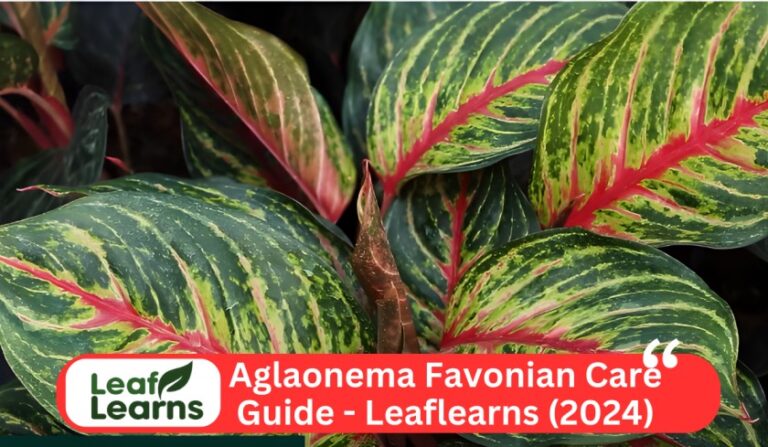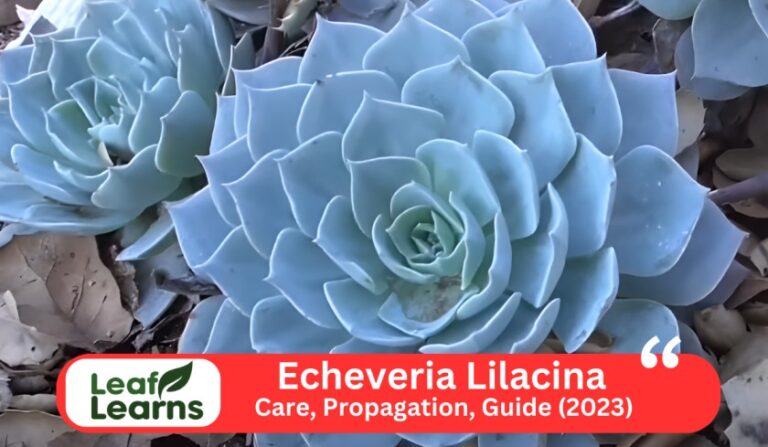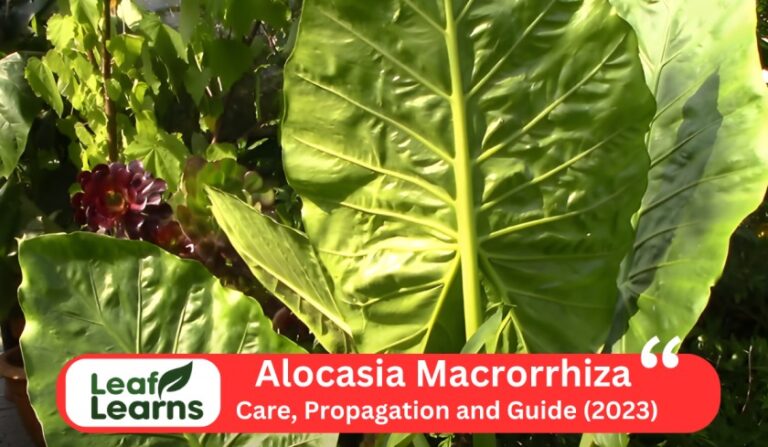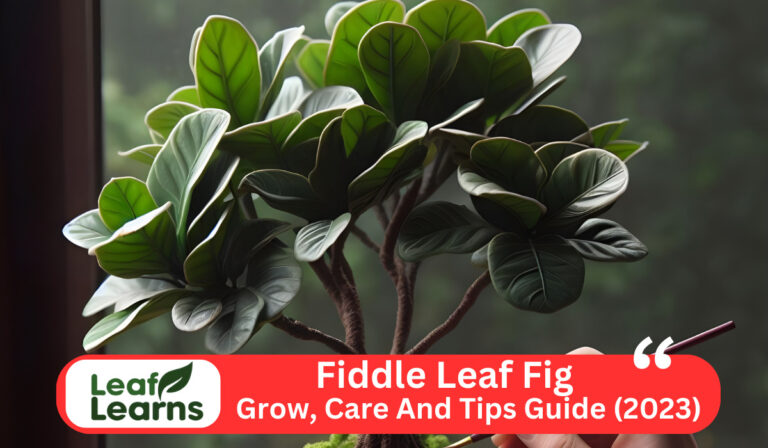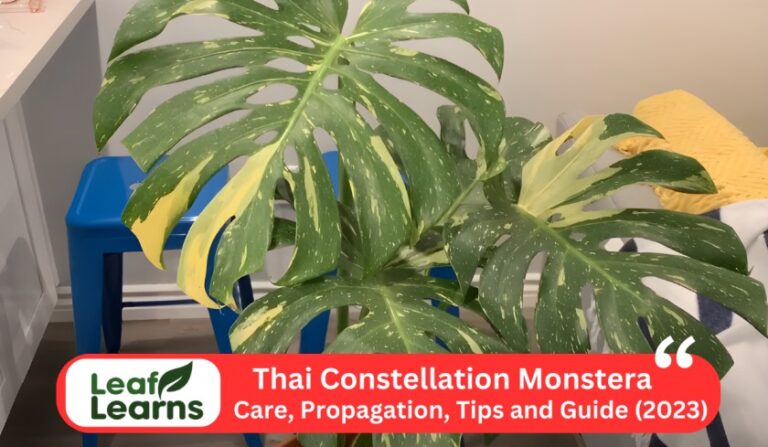Monstera Laniata Care Guide – Leaflearns (2024)
The beautiful Monstera laniata, often mistaken for an entirely different species, is in fact the subspecies of Monstera adansonii we all love. This tropical fruit comes from the green jungles of Costa Rica and Panama where it climbs as a vine and can reach up to 20 feet in height.
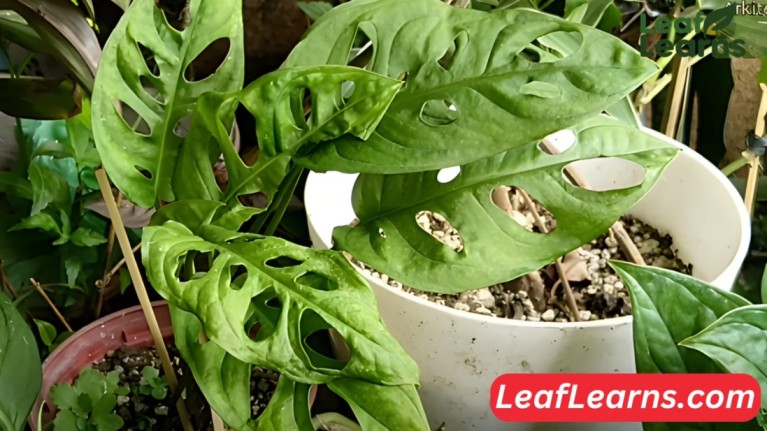
Why Monstera-Laniata is Distinctive?
- Larger, Glossier Leaves: The glossy sheen of the laniata’s robust foliage and the fine foliage of the adansonii make a striking contrast.
- Distinct Fenestrations: The fenestrations (perforations on leaves) become more irregular in laniata, being situated mainly near veins, creating an extremely complex pattern
- Variegated Variations: Rare laniatas do occur, but these special ones are painted with impressive streaks or patches of white, making them even more unique.
| Attribute | Information |
| Common name | Monstera laniata |
| Scientific Name | Monstera adansonii ssp. laniata ‘Large Form’ |
| Family | Araceae |
| Origin | Bolivia |
| Plant type | Vine |
| Size | Up to 3 meters tall |
| Lifespan | Perennial |
| Leaf Colour | Dark green |
| Leaf size | Large |
| Flower | Rarely flowers |
| Light | Bright, indirect light |
| Water | Moderate |
| Soil | Well-draining |
| Temperature | 65-85°F (18-29°C) |
| Humidity | High |
| USDA Zone | 10-12 |
| Fertilizer | Balanced liquid fertilizer monthly during the growing season |
| Propagation | Stem cuttings |
| Pruning | Prune to control size and shape |
| Pests | Mealybugs, spider mites |
| Toxicity | Toxic if ingested |
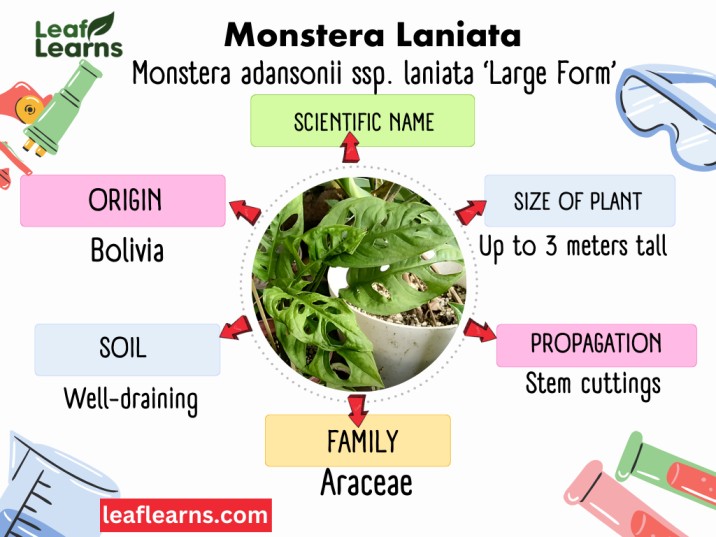
Contents
- 1 Monstera laniata Care
- 2 How to propagate monstera laniata?
- 3 Pruning
- 4 How do you repot a monstera-laniata?
- 5 Growth Rate and Size
- 6 Flowering and Foliage
- 7 Appearance and Fragrance
- 8 Common Pests and Diseases
- 9 Problems and Solutions
- 10 Toxicity for Human
- 11 Varieties/Types
- 12 Uses
- 13 Understanding the Key Differences: Monstera adansonii vs. Monstera-laniata
- 14 Exploring the Intriguing World of Variegated Monstera Varieties
- 15 FAQs
- 15.1 Is Monstera Laniata rare?
- 15.2 What’s the difference between Adansonii and Laniata?
- 15.3 How big do Monstera Laniata get?
- 15.4 How do you propagate Monstera Laniata?
- 15.5 What is the difference between Laniata and Blanchetii
- 15.6 How do you care for a Monstera Laniata plant?
- 15.7 What is the scientific name for Monstera laniata?
- 15.8 How tall does Monstera Laniata grow?
- 15.9 How fast does Monstera Laniata grow?
- 15.10 Why is my Monstera Laniata dying?
- 15.11 How cold can Monstera-Laniata tolerate?
- 15.12 Is Monstera-Laniata toxic to cats and dogs?
Monstera laniata Care
How much light does a monstera’s laniata need?
The Monstera-Laniata displays its beautiful leaves under the patterned sunlight of the sky, and it thrives in bright, indirect light.
Think about its original rainforest setting; light is filtered through the canopy, not direct, piercing sun rays. Do this by placing your plant close to an east-facing window or a few feet away from a south or west-facing one.
Stay away from the direct sunlight in the middle of the day to prevent scorching of the leaves. Turn your plant regularly for uniform growth.
How often do you water Monstera’s Laniata?
Monstera-Laniata likes constant dampness, but not soggy feet, much like a jungle resident. When the top inch of soil seems dry, aim for thorough watering, letting extra water runoff.
Rotten roots might result from overwatering. Reduce the frequency of watering throughout winter when the plant goes dormant.
What type of soil is best for Monstera-laniata?
A healthy Monstera-Laniata requires a potting mix that drains properly and is well-aerated. Seek for mixtures made especially for aroids, or mix your own with equal parts perlite, coco coir, and orchid bark.
This mixture maintains enough moisture levels for the demands of the plant while ensuring proper drainage.
Temperature Requirement
Keep your Monstera-Laniata at temperatures between 65°F and 85°F (18°C and 29°C) to evoke the warmth of the jungle.
Keep it safe from drafts and abrupt temperature changes.
Do monstera-Laniata like humidity?
Monstera-Laniata prefers 50–60% humidity, which is moderate to high. Although it adjusts to the typical humidity of a home, you may create a microclimate by putting plants in groups or using a pebble tray or humidifier.
How often should I fertilize my Monstera’s laniata plant?
Feed your Monstera-Laniata in the spring and summer, when it is actively growing. Once a month, apply a balanced, diluted liquid fertilizer. Steer clear of over fertilizing since this may harm the roots. Fertilize little or not at all in the autumn and winter.
Potting Requirement
Select a container whose drainage holes are just a little bit bigger than the root ball. When the roots outgrow the pot they are in, repot every one to two years. In the winter, avoid repotting and use fresh potting mix.
How to propagate monstera laniata?
Monstera-laniata, known for its stunning split leaves, is thankfully quite easy to propagate! Here are the two most common methods:
Water Propagation
- Tools: Sharp knife, sterilized glass jar, filtered water (change weekly)
- Steps:
- Select a robust stem that has two nodes (leaf bumps) or more, preferably an aerial root.Make a 45-degree cut underneath a node.
- To reduce water loss, remove all leaves save the top one or two.Dip the cut end, if desired, for a brief moment in rooting hormone.
- With the node immersed in water, place the cutting in the jar.Make sure the water is free of leaves.
- Leave the container in bright, indirect light and watch the roots grow—this process may take four to six weeks.
- Plant the cutting in a potting mix that drains well once the roots have taken hold and are at least one inch long.
Soil Propagation
- Tools: Sharp knife, pot with drainage holes, well-draining potting mix (e.g., aroid mix)
- Steps:
- As stated in Water Propagation, follow steps 1 and 2.
- Prepare a container with wet potting mix in place of water.
- Plant the clipping, making sure the earth covers at least one node.
- To boost humidity and create a little greenhouse, cover the pot with a plastic bag.
- Keep the soil regularly wet but not waterlogged, and place the container in bright, indirect light.
- In three to four weeks, when new growth starts to show, remove the plastic bag.
Pruning
- Why Prune? Pruning your Monstera-Laniata will limit size, encourage bigger leaves, and stimulate bushier growth. In the spring or summer, trim lanky stems above a node and pay attention to any brown, yellowing, or broken leaves.
- The Equipment of the Trade: For clean cuts and infection prevention, use sterile, sharp shears or pruners. Because the sap might irritate skin, think about wearing gloves.
- Tips for Pruning: To avoid ugly stubs, use angled cuts near the main stem or node. Recall that sometimes, less really is more! Make little incisions at first, then see how your plant reacts.
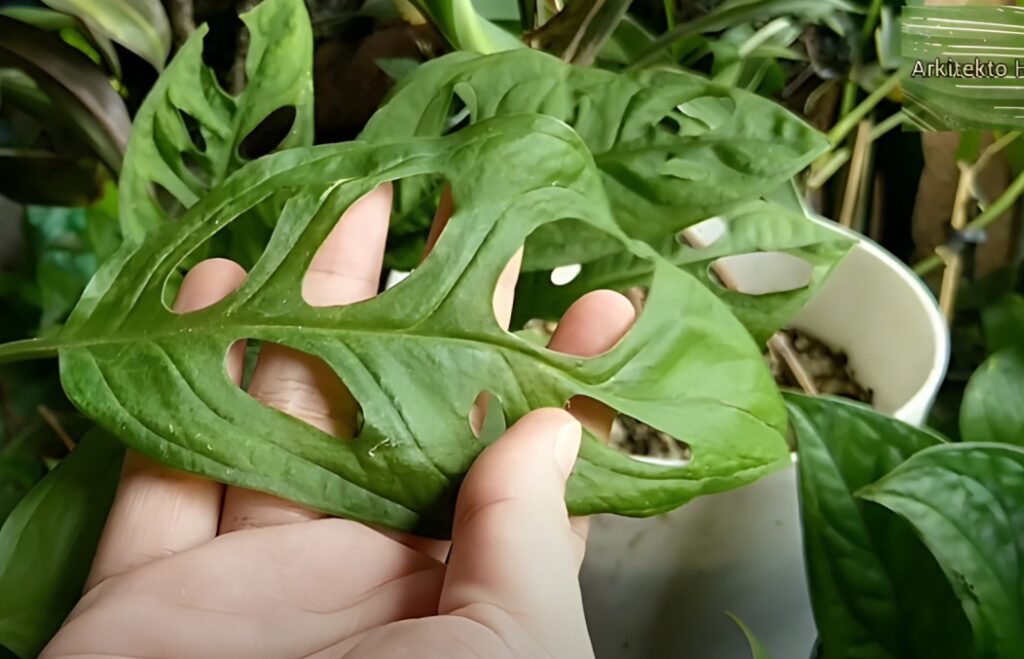
How do you repot a monstera-laniata?
Repotting is necessary when there are signs of it, such as rootbound roots showing through drainage holes, slow growth, or a pot toppling over from top weight.
Selecting the Appropriate Pot: To avoid waterlogging, choose a pot that is just two to 3 inches bigger than the existing one and has enough of drainage holes.
Ritual of Repotting: The day before you want to repot, give your Monstera-Laniata a good watering. After carefully loosening the root ball and removing any damaged or dead roots, repot the plant in a new potting mix that drains properly. Savor your revitalized plant and give it a little water
Growth Rate and Size
It is sometimes referred to as the Swiss Cheese Plant or Split-Leaf Philodendron. Indoors, it may grow as tall as 10 feet, with leaves that can spread as broad as 3 feet.
When given the right care, Monstera-laniata usually develops at a moderate to rapid rate. It may produce many new leaves in a year with strong indirect light, high humidity, and regular watering.
Flowering and Foliage
- Foliage Frenzy: The main attraction! The Laniata brings a hint of tropical flare to any area with its strikingly perforated, deeply lobed leaves. Emerging leaves have an enticing lime green colour before turning a vivid dark green as they mature.
- Flower Power? Mature Monstera-Laniata can produce cream-colored, hooded flower with a subtle, sweet aroma inside, though they are uncommon. These flowers resemble those of its near relative, the Anthurium.
Appearance and Fragrance
Picture thick, long leaves that fall in emerald tendrils. Monstera-Laniata’s striking fenestrations, or natural holes, give its lush loveliness an alluring touch.
2. Sculptural Magnificence: With a distinct split-lobe pattern, every leaf unfolds like a work of art. The plant’s captivating aerial roots, which emerge as it ages, give its tropical charm a sculptural quality.
3. Edible Mysteries: Mature Monstera-Laniatas are rarely seen blooming indoors, but when they do, they may surprise you with a delicate, vanilla- or pineapple-like perfume. A lovely treat for those who patiently raise plants!
Common Pests and Diseases
Pests
- Spider mites: Their presence is indicated by fine webbing and stippling on leaves. Use insecticidal soap or hose them down.
- Mealybugs: These sap-sucking insects are identified by cottony masses on stems and leaf undersides. Either remove them by hand or with a neem oil solution.
- Brown or silver marks are caused by tiny brown or black insects called thrips. Effective control can be achieved with insecticidal soap or neem oil solution.
- Fungus gnats are tiny flying insects that live well in moist soil. For control, install insecticidal soap or mosquito dunks in addition to improving drainage.
Diseases
- Overwatering is the cause of root rot. Waxy leaves and brown, squishy roots are warning indicators. Repot in soil that drains well, and modify your watering regimen.
- Leaf Spot Disease: Excessive moisture causes brown or yellow spots, frequently accompanied by halos, to develop on leaves. Improve ventilation, get rid of any damaged leaves, and don’t overwater.
- Bacterial Leaf Spot: This illness is indicated by yellow or red halos around brown patches. Trim diseased leaves, make sure there’s enough airflow, and keep wet off the plant.

Problems and Solutions
Problem: Drooping leaves
Solution: Verify the moisture content! While underwatering causes foliage to droop, overwatering causes root rot. Adapt your watering plan to the amount of sunshine and dryness in the soil.
Problem: Brown, mushy roots
Solution: Take off the mushy roots and quickly repot your Monstera in well-draining soil. Modify your watering practices to prevent problems later.
Problem: Yellowing leaves
Solution: Check for pests, use a balanced fertilizer if necessary, and modify light exposure according to the type of Monstera you have.
Problem: Holes in leaves
Solution: ️Natural solutions for controlling pests include neem oil and insecticidal soap. Use insecticidal sprays or horticultural oil for big infestations.
Problem: Slow growth
Solution: Make sure it receives plenty of indirect light, fertilize it once a month in the spring and summer, and keep the temperature steady between 65 and 80 degrees Fahrenheit.
Problem: No new leaves
Solution: If necessary, repot after checking for rootboundness (pot too small). During the growth seasons, make sure the humidity is between 50 and 60 percent, and fertilize often.
Toxicity for Human
Yes, Monstera Laniata is considered mildly toxic to humans due to the presence of insoluble calcium oxalate crystals in all its parts.
- Consuming leaves or stems can make the mouth, throat, and stomach feel irritated, burned, swollen, and uncomfortable.
- Most of the time, minor symptoms go away on their own, but if they worsen, get help right once.
- Youngsters and those with delicate digestive systems are more vulnerable.
Is Monstera laniata toxic to cats and pets?
It is also toxic to cats and dogs.
- Pets may experience symptoms including mouth discomfort, drooling, vomiting, and trouble swallowing, much like people.
- Some animals may get skin irritations by coming into contact with the sap.Keep Monstera-Laniata out of pets’ reach, and get in touch with your vet right once if any are ingested.
Varieties/Types
Classic Laniata: Heart-shaped, glossy leaves with many of holes in them that grow well when supported by climbing plants.
Albo: Gorgeous shape with white splotches that adds a distinctive touch to any area.
Thai Constellation: Dreamy leaves with marbling, each one a work of natural art
Uses
- Air Purifier: Laniata naturally filters toxins like formaldehyde, creating a cleaner, healthier ambiance.
- Vertical Accent: Train it up a moss pole or trellis for a dramatic, space-saving display.
- Living Art: Its captivating foliage becomes a focal point, adding vibrant energy to any room.
Understanding the Key Differences: Monstera adansonii vs. Monstera-laniata
In the world of Monstera plants, the distinction between Monstera adansonii and Monstera-laniata is crucial for enthusiasts and collectors. While both species share similarities, such as their iconic fenestrated leaves, there are notable differences.
Monstera adansonii tends to have more elongated and narrower leaves compared to the broader and more rounded leaves of laniata. Additionally, variegated varieties add another layer of intrigue to these plants.
Varieties like monstera adansonii laniata variegated albo and variegated monstera-laniata mint showcase stunning patterns and colors, captivating the attention of plant enthusiasts worldwide.
Care and propagation techniques, such as monstera-laniata mint care and how to propagate monstera-laniata, are essential for maintaining the health and vitality of these plants, ensuring they thrive in various environments.
Exploring the Intriguing World of Variegated Monstera Varieties
Furthermore, as collectors seek out rare and unique specimens, variegated varieties continue to pique interest. The possibility of a monstera becoming variegated adds an element of anticipation and excitement to caring for these plants.
Alongside the meticulous care routines, understanding the diverse range of Monstera species and their nuances, such as monstera-laniata ghost and Monstera-laniata frozen freckles, enhances the appreciation for these botanical wonders.
From the towering monstera deliciosa to the intricately patterned variegated forms, each Monstera variety offers its own charm and allure, making them cherished additions to any plant collection.
FAQs
Is Monstera Laniata rare?
Not always! It’s less common than the Adansonii, but you can still get it easily in plant stores and online. Due to their great demand, some variegated varieties, such as “Albo” or “Thai Constellation,” may cost more.
What’s the difference between Adansonii and Laniata?
Laniata is similar but has bigger, glossier leaves with more noticeable holes. Furthermore, as it ages, Laniata loses its petiole wings (leaf sheath), whereas Adansonii keeps them.
How big do Monstera Laniata get?
With support, it can reach impressive heights of 6-8ft! When left trailing, it spreads horizontally.
How do you propagate Monstera Laniata?
Stem cuttings in water or moist soil are popular methods. Ensure a node (leaf-stem junction) is present for growth.
What is the difference between Laniata and Blanchetii
Blanchetii maintains its petiole wings and has wider, less-perforated leaves compared to Laniata’s distinct holes.
How do you care for a Monstera Laniata plant?
Bright, indirect light, well-draining soil, moderate watering, and occasional misting for humidity are key.
What is the scientific name for Monstera laniata?
While previously classified as “Monstera Laniata,” it’s now recognized as “Monstera adansonii subsp. laniata.”
How tall does Monstera Laniata grow?
Up to 6-8ft with support, remaining shorter and bushier when trailing.
How fast does Monstera Laniata grow?
Moderate. Expect new leaves every few months with proper care.
Why is my Monstera Laniata dying?
Common culprits include overwatering, root rot, lack of light, pests, or nutrient deficiency. Check these factors and adjust care accordingly.
How cold can Monstera-Laniata tolerate?
Avoid temperatures below 60°F (15°C). Protect from drafts and sudden temperature drops.
Is Monstera-Laniata toxic to cats and dogs?
Yes, both leaves and berries contain insoluble calcium oxalate crystals, causing oral irritation and vomiting in cats and dogs. Keep out of reach


